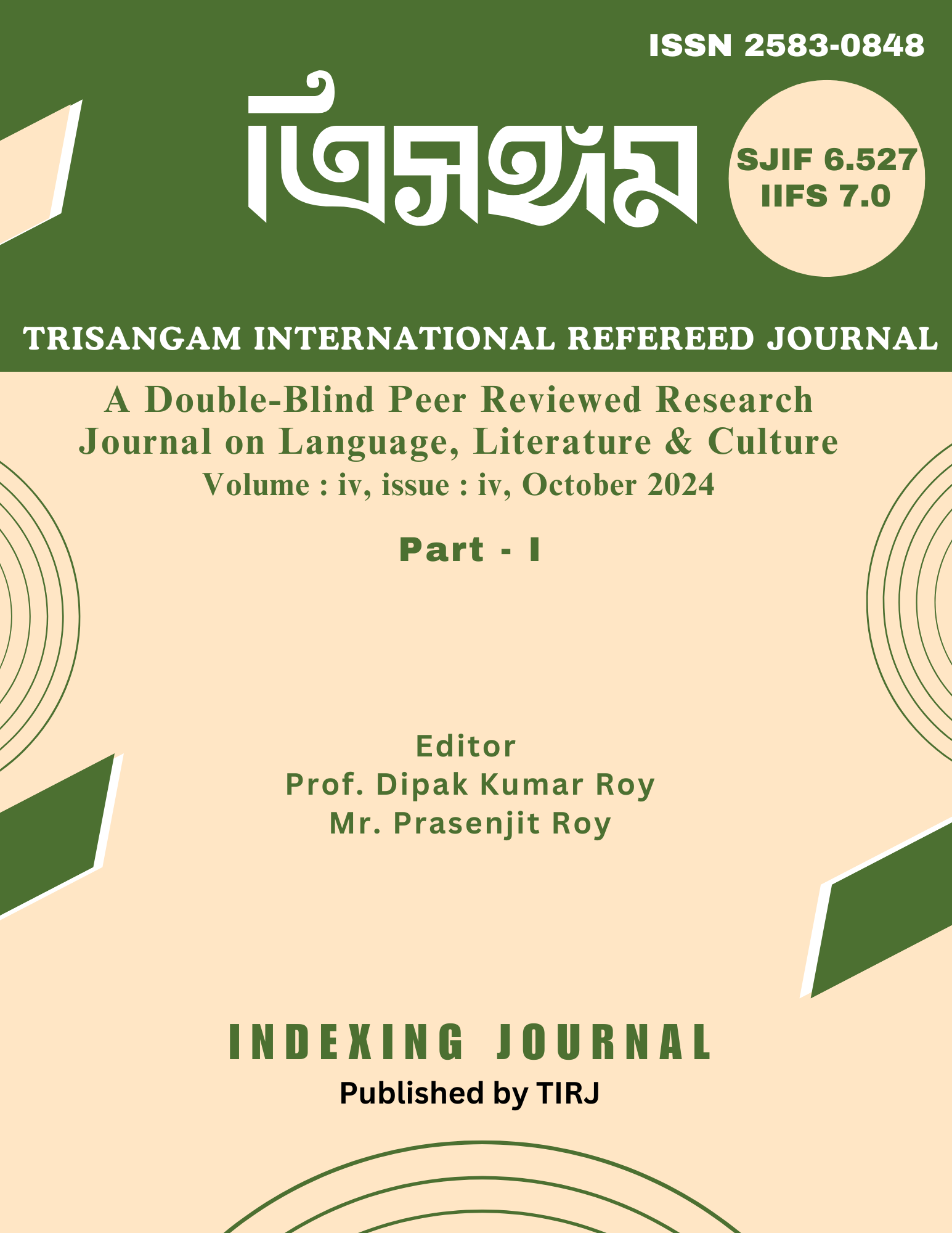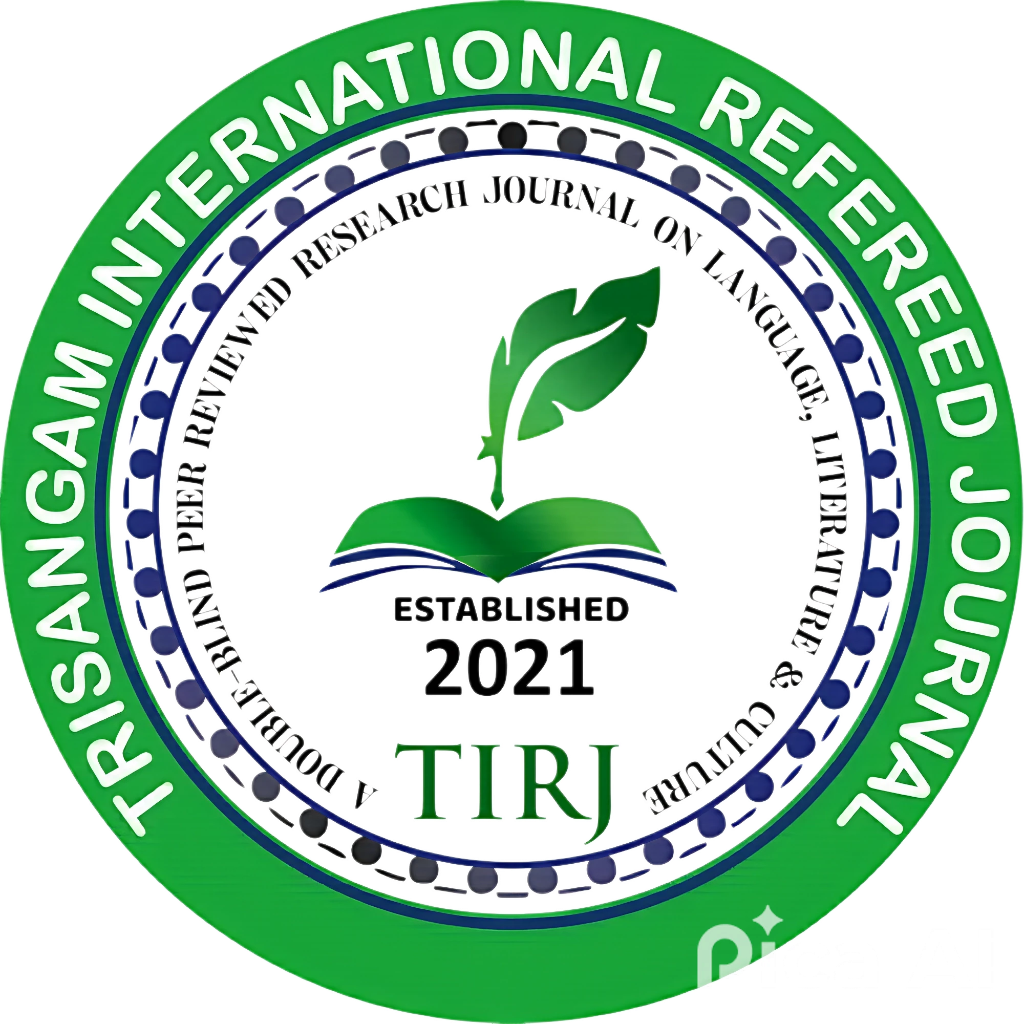Michael Madhusudan Dutt’s Views on Radha : In the Context of Brajangana Kavya/ মাইকেল মধুসূদন দত্তের রাধা ভাবনা : প্রসঙ্গ ব্রজাঙ্গনা কাব্য
Keywords:
- Michael Madhusudan Dutta,
- Radha,
- Krishna,
- Brajangana Kavya,
- Modernity,
- Secular,
- Humanity,
- Lover-Goddess,
- Mother-Goddess,
- Biraha,
- Parakiya
Abstract
Among Madhusudan's poetic works 'Brajangana' is exceptional in terms of subject and style. Madhusudan chose the subjects of his other three epics, from the Ramayana, Mahabharata and Puranas. Compared to that, the main character of 'Brajangana Kavya' is Radha, who is originated from folk culture. On the other hand, the lyricism which Madhusudan considered as a weakness of Bengali poetry, in this poem he has chosen the style of lyricism. What is the reason for this? In Madhusudan's conception of Radha we see the expression of his novelty. Referring to Radha in a letter to his friend Gourdas Basak, Madhusudan said, to read poetry free from religious influence, Radha is not an 'evil' character. He also said, 'The absurd group of poets has composed poetry based on the story of the legend; Their wicked, uncultured, tasteless imaginations are responsible for Radha's present plight'. In the socio-economic context of the 19th century, Madhusudan's view on Radha was revolutionary and an under-discussed aspect of modernity are evaluated in this article. Radha is quite distinct from the Matriarchal Goddess images like Uma or Kali. Radha is a Lover-Goddess like the Greek mythological Venus - which distinguishes Radha from Mother-Goddess like Uma, Parvati or Kali. Radha is not given much status in Puranas or scriptures. Later, while Radha was given a place in mainstream scriptures or literature, her character's grandeur was greatly diminished. Medieval literature centered on Radha is no exception. But Michael Madhusudan Dutta in his 'Brajangana Kavya' presents us with a 'human', 'personable' Radha - breaking the archetype of 'goddess', 'maid' or 'servant' Radha. The human side of Radha is magnified by Madhusudan in his 'Brajangana Kavya'.
Downloads
References
১. মুখোপাধ্যায়, শক্তিসাধন, ইতালীয় রেনেসাঁসের আলোকে বাংলার রেনেসাঁস, প্রগ্রেসিভ পাবলিশার্স, কলকাতা, জুলাই, ২০০৫, পৃ. ২০৫
২. গুপ্ত, ক্ষেত্র (সম্পাদিত), মধুসূদন রচনাবলী, সাহিত্য সংসদ, কলকাতা, জুলাই, ২০১৭, পৃ. ৫২৫
৩. তদেব, পৃ. ৫৫০
৪. গুপ্ত, ক্ষেত্র, কবি মধুসূদন ও তাঁর পত্রাবলী, গ্রন্থনিলয়, কলকাতা, ১লা বৈশাখ, ১৩৭০, পৃ. ১৩০
৫. গুপ্ত, ক্ষেত্র (সম্পাদিত), পূর্বোক্ত মধুসূদন রচনাবলী, পৃ. ছত্রিশ
৬. তদেব, পৃ. সাঁইত্রিশ
৭. মুরশিদ, গোলাম, আশার ছলনে ভুলি, আনন্দ পাবলিশার্স প্রাইভেট লিমিটেড, কলকাতা, জুন ২০১১, পৃ. ১৮৪
৮. গুপ্ত, ক্ষেত্র, পূর্বোক্ত কবি মধুসূদন ও তাঁর পত্রাবলী, পৃ. ১৫৭
৯. বন্দ্যোপাধ্যায়, শ্রীকুমার, রবীন্দ্রসৃষ্টি সমীক্ষা, ওরিয়েন্ট বুক কোম্পানি, কলকাতা, ১৪০০ বঙ্গাব্দ, পৃ. ২৫
১০. দাশগুপ্ত, শশিভূষণ, শ্রীরাধার ক্রমবিকাশ দর্শনে ও সাহিত্যে, এ. মুখার্জী এন্ড কোং প্রা: লি:, কলকাতা, জানুয়ারি ২০১৪, পৃ. ১১৩
১১. Das, Sisirkumar, The Mad Lover, Papyrus, Kolkata, 1984, p. 70-71
১২. Ibid., p. 71.
এ প্রসঙ্গে শিশিরকুমার দাশ উক্ত গ্রন্থের ৭১ পৃষ্ঠায় সংস্কৃত প্রেম-কাহিনীর সাধারণ বৈশিষ্ট্য বিষয়ে অধ্যাপক সুশীল কুমার দে’র একটি মন্তব্য উদ্ধৃত করেছেন। এখানে মন্তব্যটি উদ্ধার করা হল— ‘Ones S. K. DE remarked about the general feature of Sanskrit love poetry that it ruled out ‘personal passion and permit the theme, not of a particular woman, a Laura or a Beatrice, but of a woman as such, provided she is young and beautiful’.
১৩. Ibid.
১৪. Ibid.
১৫. বন্দ্যোপাধ্যায়, সুমন্ত, তেলও পুড়বে না রাধাও নাচবে না একটি দেবীর রূপান্তর, উনিশ শতকের কলকাতা ও সরস্বতীর ইতর সন্তান গ্রন্থের অন্তর্ভুক্ত, অনুষ্টুপ, কলকাতা, জানুয়ারি ২০১৩, পৃ. ১৫৮
১৬. তদেব, পৃ. ১৫৮-১৫৯
১৭. তদেব, পৃ. ১৫৯
১৮. তদেব পৃ. ১৫৯-১৬০
১৯. গুপ্ত, ক্ষেত্র, মধুসূদনের কবি-আত্মা ও কাব্যশিল্প, এ. কে. সরকার অ্যান্ড কোং, কলকাতা, আশ্বিন ১৪১৮, পৃ. ৮৮-৮৯
২০. ঝা, শক্তিনাথ, অন্য এক রাধা, মনফকিরা, কলকাতা, নভেম্বর ২০০৯, পৃ. ৭
২১. গুপ্ত, ক্ষেত্র, (সম্পাদিত), পূর্বোক্ত মধুসূদন রচনাবলী, পৃ. ১১৯
২২. তদেব
২৩. তদেব, পৃ. ১২০
২৪. তদেব, পৃ. ১২১
২৫. ঘোষ, সঞ্জয়কুমার, ব্রজাঙ্গনা কাব্য মাইকেল মধুসূদনের এক অভিনব সৃজন, সাহিত্য-পরিষৎ পত্রিকা, মাইকেল মধুসূদন দত্ত বিশেষ সংখ্যা, ১৩০ বর্ষ ৩ সংখ্যা ১৪৩০, পৃ. ২৪০
২৬. গুপ্ত, ক্ষেত্র (সম্পাদিত), পূর্বোক্ত মধুসূদন রচনাবলী, পৃ. ১২১
২৭. মুরশিদ, গোলাম, আশার ছলনে ভুলি, পূর্বোক্ত, পৃ. ৫৪-৬৪
২৮. গুপ্ত, ক্ষেত্র (সম্পাদিত), পূর্বোক্ত মধুসূদন রচনাবলী, পৃ. ১২৮
২৯. তদেব, পৃ. ১২৯
৩০. তদেব, পৃ. ১২১
৩১. মুরশিদ, গোলাম, আশার ছলনে ভুলি, পূর্বোক্ত, পৃ. ১৮৩
৩২. এই বিষয়ে বিস্তৃত আলোচনা পাওয়া যাবে, শশিভূষণ দাশগুপ্ত, শ্রীরাধার ক্রমবিকাশ দর্শনে ও সাহিত্যে, এ. মুখার্জী এন্ড কোং প্রা: লি:, জানুয়ারি ২০১৪, কলকাতা; সতী ঘোষ, বাংলা সাহিত্যে বৈষ্ণব পদাবলীর ক্রমবিকাশ, সারস্বত লাইব্রেরি, বৈশাখ ১৩৬৭, কলিকাতা; সতী ঘোষ, ভারতের বৈষ্ণব পদাবলী, পশ্চিমবঙ্গ রাজ্য পুস্তক পর্ষদ, প্রথম প্রকাশ ১৯৫৭, কলকাতা; সুমন্ত বন্দ্যোপাধ্যায়, তেলও পুড়বে না রাধাও নাচবে না একটি দেবীর রূপান্তর, উনিশ শতকের কলকাতা ও সরস্বতীর ইতর সন্তান গ্রন্থের অন্তর্ভুক্ত, অনুষ্টুপ, জানুয়ারি ২০১৩, কলকাতা; শক্তিনাথ ঝা, অন্য এক রাধা, মনফকিরা, নভেম্বর ২০০৯, কলকাতা; বলদেব উপাধ্যায়, ভারতীয় বাণ্ডময় ম্যায় শ্রীরাধা, বিহার রাষ্ট্রভাষা পরিষদ, ২০০১, পাটনা, বিহার; Harsha V. Dehejia edited, Radha : From Gopi to Goddess, Niyogi Books, 2014, New Delhi প্রভৃতি।






